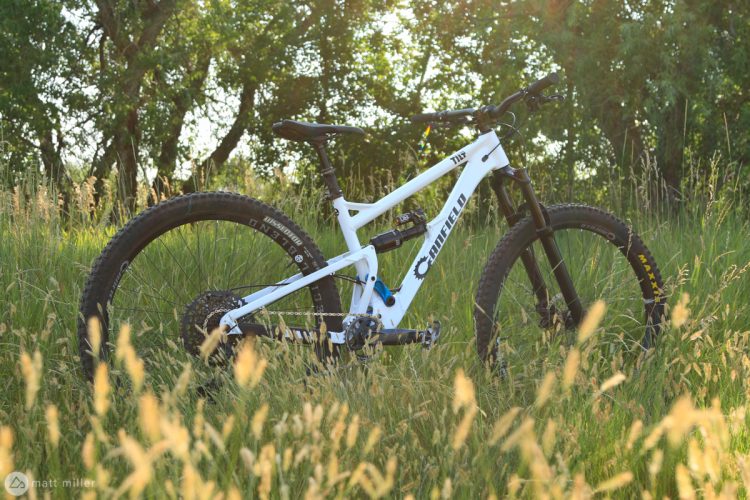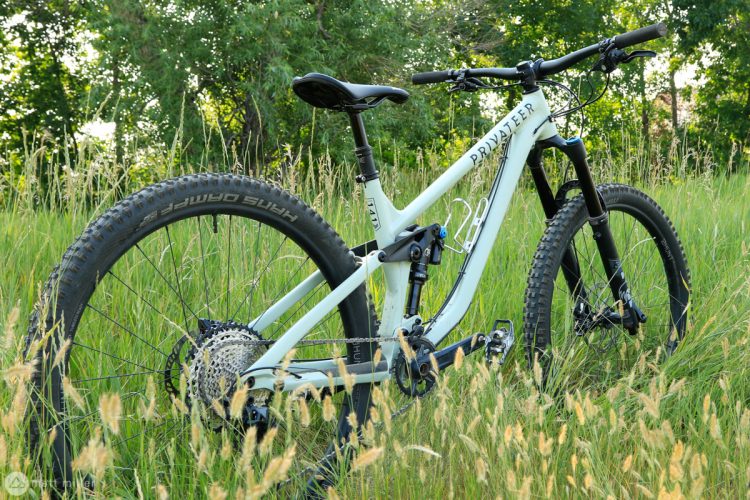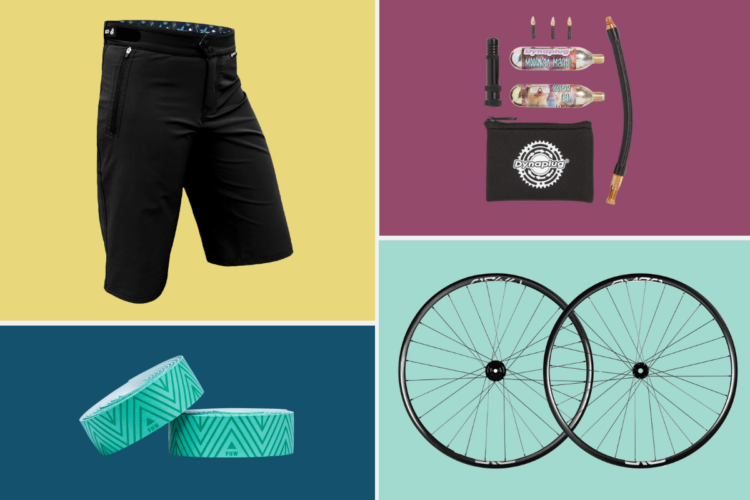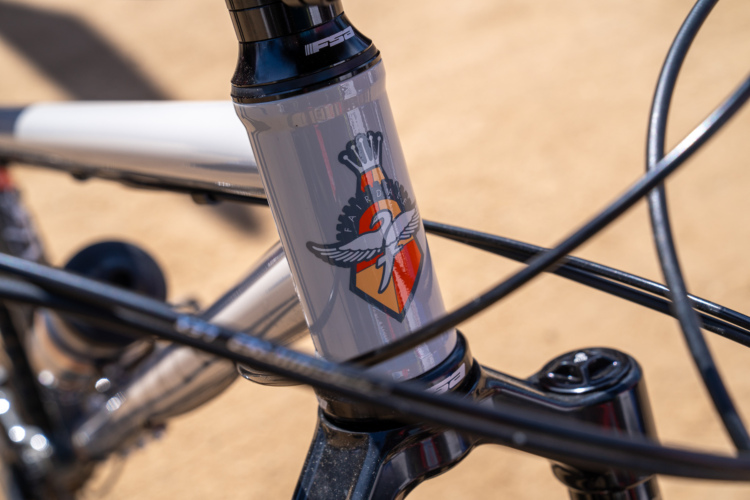Check out the 2021 Singletracks Mid-Travel Mashup reviews on Singletracks and video reviews on our YouTube channel.
Between feathery XC bikes and brutish enduro race frames, there’s a sea of variety for brands to float on. They’re not as constrained by athlete expectations around weight, agility, or even geometry. Oftentimes, if a brand makes both 27.5″ and a 29″ versions of their mid-travel offering, the larger wheels belong to the speed-plow, and the smaller diameter is for partying. While I only tested one of the Escarpe models, it’s clear Vitus didn’t follow that thinking with this 29er. This bike knows how to dance.

The Escarpe 29 CRS has 140mm of rear travel behind a 150mm fork, with a full alloy rear end attached to the same carbon front triangle as the brand’s Sommet enduro race frame. Sharing the front triangle means that the company has to purchase fewer carbon molds, which is likely reflected in the bike’s decidedly affordable retail tag. This build sells for £2,699.99/$3,299.99 with either wheels size, and there is a build below it that goes for £1,999.99/$2,699.99 or a Kashima-coated model that retails for £3,499.99/$4,299.99. A frame set and Fox DPS Factory shock will drain £1,499.99/$1,999 from your wallet. No matter which component set you’re into, this is a solid bike for the price.
Test pilot profile height: 5’9″ (175cm) weight: 145lbs. (66kg) testing zone: Northern Italy
Frame facts


Escarpe frames offer as much mud clearance as you’d expect from a bike designed in Ireland. The chainstay brace sits a healthy distance form the 2.4″ Maxxis Dissector tire, leaving ample space for crud to pass. The larger gap between that alloy brace and the front triangle allows mud to clear quite easily, possibly foregoing the need for moto foam in that common pinch point. Thanks to the sturdy one-piece rocker-link the seat stays don’t use a brace behind the seat tube, and the mud clearance is virtually unlimited. Speaking of slop, the down tube on this bike is rather massive, intercepting a good amount of debris on its way from the tire to your face.
This frame has some good looking paint, and it’s well protected by a clear plastic film that can be replaced or removed as it gets dinged up. The protection kit comes installed on all Vitus mountain bikes, including à la carte frame sets. Slap-silencing on the alloy rear triangle is decent, covering the upper chain stay and inner seat stay. The rubber slabs could be thicker to further reduce chain noise, but overall they get the job done. The downtube protection is similarly adequate for stone strikes, and since the carbon tube doesn’t protrude past the length of the crank arm, there’s a good chance any larger impacts will hit your foot or the crank before making contact with the down tube.


Cable routing inside the Escarpe frame is loose, meaning that the brake hose and cable housing are not guided through tubes. Surprisingly, those free-floating cables haven’t made any noise throughout testing, and there are plenty of tricks to secure them inside the frame if riders start hearing them slap about. The windows where cables enter and exit are rather large, making it easy enough to route cables without guides when it’s time for a swap. Those same plastic windows are larger than their adjacent holes, making it difficult to accidentally drop them inside the frame.
One of the few strikes against this frame is that the brake hose and derailleur cable exit the down tube and pass beneath the BB to reenter the chain stays. While this routing makes for a gentler bend with less stress on those cables, it also places them in the firing line to be destroyed by rocks and caught on passing sticks. I didn’t manage to get anything caught in them, but I have with other bikes, and I’m definitely not a fan of this routing layout. Even if the likelihood is low that you would smash a stone hard enough to sever the brake line, I feel uneasy about taking that unnecessary chance. While easier typed than designed, I’d love to see them move these vital veins out of harm’s way.

Escarpe frames use a Trunnion-mounted 205x60mm shock, and the lower link is connected to a flip-chip between two carbon fiber braces near the BB. The braces and rocker link look extra sturdy, which is always good to see when running Trunnion shocks that can be susceptible to damage from rotational forces. The shock’s placement keeps it out of the main mud line, and leaves the air valve and external adjustment knobs easily accessible.
I’m perpetually between a size medium and large with most frames, where a large can take more work to maneuver, and a medium often feels short and shivery. My ideal size seems to be those unicorns with 465mm reach measurements. To simplify things for this Mid-Travel Mashup, I went with the size that the brands suggested for my stature.
With an agile-enough 65° head tube angle, a steeper 77° seat tube, and a properly squatty 35mm bottom-bracket drop, I didn’t see any reason to switch the flip chip into “high.” The chip steepens the HTA by 0.5° and raises the BB by 6mm, neither of which would make the bike ride better on our local singletrack. The chainstays are 440mm long on all four frame sizes, and I figured that length should balance well with the 451mm reach on the size medium I tested.
While the medium Escarpe’s 625mm stack height is fairly average, the steerer tube was cut a little too short for my liking. The stock Nukeproof Horizon handlebar kicks up 20mm of rise, and with just 10mm of spacers beneath the 45mm-long stem I found myself wanting more steerer tube to adjust bar height. This could easily be solved by swapping in a handlebar with more rise, but it would be even simpler to cut the steerer longer to begin with.
Build spec

Buyers get a sensible build kit for the price of this bike. Down at the trail end, the DT Swiss M1900 wheels are wrapped in a Maxxis Assegai and Dissector tread with EXO+ casings. The full drivetrain is Shimano SLX 12-speed, with an SLX 2-piston brake out back and a 4-piston caliper bolted to the RockShox Pike Select. The forward rotor measures 203mm across, while the one next to the cassette is 180mm. The shock is a RockShox Deluxe Select+ that offers both low-speed rebound adjustment and a compression switch to firm things up.

Nukeproof and Vitus share a retail outlet in Chain Reaction Cycles, and I had assumed that every other component on the Escarpe would come from Nukeproof. The cockpit and saddle are both Nukeproof branded, while the grips and seat-post clamp bear the Vitus name, and the headset comes form Acros. The 150mm dropper post is from another CRC brand that’s aptly named Brand-X. After a few seasons on 170mm droppers this one felt fairly short, and I would definitely swap it for additional drop.
I’ve had zero issues with the components on this bike, and would be stoked on the build if this were my personal partner. I would eventually swap in a 4-piston rear brake caliper for a little more power, elongate the dropper, and clamp a handlebar with more rise, but otherwise the build really doesn’t need to be upgraded. In fact, I might suggest a downgrade to the entry-level model that comes with a Marzocchi Bomber Z2 fork, a durable Shimano Deore drivetrain, and a similar shock that keeps the rebound adjust and ditches the two-position compression switch—which you really don’t need with this suspension layout.
Pedaling prowess

The engineers at Vitus have done a great job dialing in the anti-squat and shock tune for this frame, and it rides high with little bobbing at about 25% sag. Folks who prefer cozier suspension with deeper static sag might find the compression switch more useful, but I am able to leave it flipped open nearly all the time. I do close it on paved climbs just to save a watt or two, but even on the smooth stuff there’s very little shock movement while pedaling.
A platform with this much support can occasionally come at the expense of climbing grip, but this one wins there too. The rear suspension makes way for all sorts of small impacts and ledges on technical climbs, leaving all dabs and slipped tires to rider error alone. While the Dissector tread pattern was drawn with fast and dusty DH in mind, it offers a nice amount of uphill grip as long as the soil is dry.

A medium Escarpe 29 with this build weighs a respectable 14.9kg (32.8lbs) which feels a fair bit easier to pedal uphill than my 17kg long-travel bike. The bike’s heft is well balanced, both on the climb and in the air. Grams could be cut with a lighter saddle, carbon handlebar, a lighter wheel set, and upgraded cranks and cassette, but this bike isn’t begging to be lighter. The weight feels just right given the platform’s intentions, and compared to similar bikes I’ve tested its on-trail character is on the lighter side.
Of course, this little red rocket’s geometry also plays an important role in its climbing prowess. With the BB nearly centered between the handlebars and the rear axle, and a steeper 77° seat tube angle, the climbing position is markedly comfortable. It’s a cinch to keep the front tire planted on steeper climbs, which certainly helps when you’re trying to navigate tight rock problems. The Escarpe earns the title of “all-mountain bike” for its enjoyable demeanor on all sorts of long trails.
Descent details

Here we have a 140/150mm 29er with a relatively slack head tube angle and some DH tread, so it must be a straight-line tank on descents, right? Nope. Not even close. This carbon and alloy mixed frame falls hard toward the rabbit’s edge of the rabbit-to-rhino spectrum, to the point that I would recommend it to friends who only ride 27.5″ wheeled bikes. It bobs and weaves with glee, changing lines and launching from one root to the next like a squirrel aloft between tree branches. Yup, it’s a squirrel of a 29er.
With a progressivity percentage in the mid 20’s, it’s not the suspension alone making the Escarpe hop around. I left the shock alone, with its stock number of volume spacers, and that’s not that sole variable either. It’s more of a well planned system of bits that come together in this fun-factory of a machine. I put a friend on the bike who loves to jump high and long, and the review was glowing.
Some bikes with similar travel numbers are poised to line up at your local enduro race. For example, there were athletes racing EWS events on the 130mm Forbidden Druid until just last season when the brand came out with a longer-travel frame. The Escarpe seems to intentionally lean away from those mini-enduro machines. All of its squirrel spirit comes at a cost, in the form of a less grounded feeling ride on the rough stuff. You certainly can race an enduro on it, and you can ride it fast through a gnarly rock garden, but there are far better bikes out there if that’s the sort of ride you’re after. The Escarpe feels like a bike that woke up on the morning of the race to say “naw, I’m going to play in the woods with friends instead, and maybe I’ll hit some fun jumps.” The bike has its own definitive character, and it leaves the racing vibes to its longer travel neighbor, the Sommet.

Depending on the park, this could be a fun little bike-park ripper, for the right person. Folks who enjoy flow trails in the park, popping all the lips and pumping through berms, will have a grand time on the Escarpe. It wouldn’t be my choice for a short travel ride down the double-black tracks, but for pure party lapping on some purpose-built singletrack it’s potentially the first 29er that I would turn to. The lower weight coupled with the suspension’s high-pop characteristics make for a fun spring to push against.
Like the frame’s anti-rise values shining while climbing, the Vitus engineers have also dialed the bike’s anti-squat to keep the rear end a little higher under heavy braking. Since the rear end doesn’t drop much when you’re pulling the brakes with full steam you will need to add a fair bit of air and low speed compression to the fork in order to maintain the bike’s geometry on steeper inclines. I first had the Escarpe set up with the recommended suspension settings and sag, and the fork tended to dive and felt underpowered, causing the bike to become unbalanced and the head tube to steepen at the worst possible moment. Much of that can be remedied with added fork pressure and a slightly softer shock, though the rear tire still breaks loose and skips a little more than some similar bikes when the calipers bite down hard.
To add to its boundful demeanor, the average length 440mm chain stays leave the bike easy to pull off the lip of jumps or to manual across creeks. My rear-wheel riding skills are severely lacking, and the Escarpe makes it easy to hold that front tire above the water long enough to keep my feet dry. The bike wants to gap as many mounds or roots as you do, and it’s undoubtedly the 29-inch-footed squirrel for your friend who can’t be convinced that 29ers are fun too.
The YT Jeffsy Base that we reviewed last year sits at a similar price range, with 10mm more travel at the rear axle and a full alloy frame. With its lower weigh and suspension kinematic differences, the Escarpe is a fair bit more agile than the Jeffsy Base. If a rider were to take the two bikes down the same messy natural descent, the Jeffsy would likely be faster, while the Escarpe might be more fun.
In conclusion

The Vitus Escarpe is a fun lovin’ ride that’s comfortable to pedal deep into the hills. The price-per-pound is hard to beat with a new bike, and there’s not much that needs to be upgraded upon purchase. It’s a sweet option for folks on a tighter budget, and it will suit the mid-travel needs of most riders who care more about riding-style points than they do K/QOM stats. The factory-installed paint protection is a huge bonus, keeping the bike clean and gouge-free longer.
Pros and cons of the Vitus Escarpe 29 CRS
Pros
- Solid build and frame at a low price
- Supportive suspension
- Comfortable geo for climbing and descending
Cons
- Steerer tube cut too short
- Brake and derailleur routing below the BB
- Not the mini-enduro some riders may be looking for
Show your Support
Become a Singletracks Pro Supporter today and enjoy benefits like ad-free browsing.
With your support we can provide free worldwide trail information and original content created by our team of independent journalists.



















